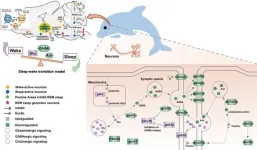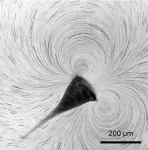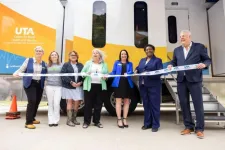(Press-News.org) LOS ANGELES — Researchers with City of Hope, one of the largest and most advanced cancer research and treatment organizations in the United States, with its National Medical Center in Los Angeles ranked among the nation’s top 5 cancer centers by U.S. News & World Report, and MSK have created a tool that uses machine learning to assess a non-Hodgkin lymphoma (NHL) patient’s likely response to chimeric antigen receptor (CAR) T cell therapy before starting the treatment, according to study results published today in Nature Medicine.
CAR T cell therapy is one of the most promising recent advances made in the fight against blood cancers. But more than half of NHL patients who do not respond to standard lines of treatment also relapse or progress within six months of CAR T therapy.
Known as InflaMix (Inflammation Mixture Model), the new tool was developed to assess inflammation, a potential cause of CAR T failure, by testing for a variety of blood biomarkers in 149 patients with NHL. With the help of machine learning, a type of artificial intelligence that uses algorithms to learn from sets of information and draw conclusions from patterns found in that data, the model was able to find an inflammatory biomarker from a series of unique blood tests not usually employed in standard clinical practice.
By analyzing the inflammatory signature that InflaMix identified, the researchers found it was associated with a high risk of CAR T treatment failing, including increased risk of death or disease relapse. InflaMix is an unsupervised model, meaning that it was trained without any knowledge of clinical outcomes.
“These studies demonstrate that by using machine learning and blood tests, we could develop a highly reliable tool that can help predict who will respond well to CAR T cell therapy,” said Marcel van den Brink, M.D., Ph.D. president of City of Hope Los Angeles and City of Hope National Medical Center, the Deana and Steve Campbell Chief Physician Executive Distinguished Chair in Honor of Alexandra Levine, M.D., and a senior author of the paper. “With a rigorous statistical approach, we demonstrated that this is one of the most thoroughly validated tests we have for predicting CAR T outcomes in lymphoma patients and could be used by oncologists everywhere to assess the risk of CAR T in an individual patient.”
According to the team, the machine learning model is very flexible and worked well even when they used only six available blood tests — all of which are typically evaluated for patients with lymphoma — to assess InflaMix’s capabilities with less data. Researchers said this is important because it means this test can be made available for most, if not all, patients with lymphoma.
“Prior studies had hinted that inflammation might be a risk factor for poor CAR T cell efficacy,” said medical oncologist Sandeep Raj, M.D., who specializes in bone marrow transplants at MSK and is lead author of the Nature Medicine paper. “Our goal was to refine this concept and build a robust and reliable clinical tool that characterizes inflammation in the blood and predicts CAR T outcomes.”
Studies of three independent cohorts comprising 688 patients with NHL who had a wide range of clinical characteristics and disease subtypes and used different CAR T products were also used to validate the team’s initial findings.
Next, City of Hope and MSK researchers plan to investigate whether blood inflammation defined by InflaMix directly influences CAR T cell function and learn more about the source of this inflammation.
“InflaMix could be used to reliably identify patients who are about to be treated with CAR T and are at high risk for the treatment not working,” said Dr. Van den Brink. “By identifying these patients, doctors may be able to design new clinical trials that can boost the effectiveness of CAR T with additional treatment strategies.”
City of Hope, a recognized leader in CAR T cell therapies for blood and other cancers, has treated more than 1,700 patients since its CAR T program started in the late 1990s. The institution continues to have one of the most comprehensive CAR T cell clinical research programs in the world — it currently has about 70 ongoing clinical trials using immune cell products, mostly CAR T, for blood cancers and 15 different solid tumor types. These products include City of Hope-developed therapies and industry-sponsored treatments.
The team’s studies were funded in part by the National Institutes of Health, the National Cancer Institute and an MSK Support Grant. The work was primarily done at MSK where Dr. Van den Brink worked for more than two decades before coming to City of Hope in 2024.
# # #
About City of Hope
City of Hope's mission is to make hope a reality for all touched by cancer and diabetes. Founded in 1913, City of Hope has grown into one of the largest and most advanced cancer research and treatment organizations in the U.S., and one of the leading research centers for diabetes and other life-threatening illnesses. City of Hope research has been the basis for numerous breakthrough cancer medicines, as well as human synthetic insulin and monoclonal antibodies. With an independent, National Cancer Institute-designated comprehensive cancer center that is ranked top 5 in the nation for cancer care by U.S. News & World Report at its core, City of Hope brings a uniquely integrated model that spans cancer care, research and development, academics and training, and a broad philanthropy program that powers its work. City of Hope’s growing national system includes its Los Angeles campus, a network of clinical care locations across Southern California, a new cancer center in Orange County, California, and cancer treatment centers and outpatient facilities in the Atlanta, Chicago and Phoenix areas. City of Hope’s affiliated group of organizations includes Translational Genomics Research Institute and AccessHopeTM. For more information about City of Hope, follow us on Facebook, X, YouTube, Instagram and LinkedIn.
END
New projections by the UNSW Institute for Climate Risk & Response (ICRR) reveal a 4°C rise in global temperatures would cut world GDP by around 40% by 2100 – a stark increase from previous estimates of around 11%.
The recently-published analysis fixes an oversight in the current economic model underpinning global climate policy, toppling previous carbon benchmarks.
The results support limiting global warming to 1.7 °C, which is in line with significantly faster decarbonisation goals like the Paris Agreement, and far lower than the 2.7°C supported ...
While the Middle Paleolithic period is viewed as a dynamic time in European and African history, it is commonly considered a static period in East Asia. New research from the University of Washington challenges that perception.
Researchers discovered a complete Quina technological system — a method for making a set of tools — in the Longtan site in southwest China, which has been dated to about 50,000 to 60,000 years ago. Quina technology was found in Europe decades ago but has never before been found in East Asia.
The team published its findings March ...
Whales and dolphins sleep by turning off one half of their brains at a time; scientists discover more about the genes and pathways that enable this phenomenon.
####
Article URL: https://plos.io/4c9g5gm
Article Title: Evolution of canonical circadian clock genes underlies unique sleep strategies of marine mammals for secondary aquatic adaptation
Author Countries: China
Funding: This work was supported by the National Key Research and Development (R&D) Program of China (grant no. 2022YFF1301600) to G.Y. & S.X., the Key Project ...
Life emerged on Earth some 3.8 billion years ago. The “primordial soup theory” proposes that chemicals floating in pools of water, in the presence of sunlight and electrical discharge, spontaneously formed organic molecules. These building blocks of life underwent chemical reactions, likely driven by RNA, eventually leading to the formation of single cells.
But what sparked single cells to assemble into more complex, multicellular life forms?
Nature Physics published a new insight about a possible driver of this key step in evolution — the fluid ...
ALL ALS Consortium Launches Website to Advance ALS Research
The Access for All in ALS (ALL ALS) Consortium announced the launch of its official website, creating a central hub for information about its initiatives and clinical research studies. ALL-ALS.org is designed to inform and engage researchers, clinicians, and current and prospective study participants.
The ALL ALS Consortium formed in fall 2023 with funding from the National Institutes of Health (NIH). The consortium consists of 35 clinical sites in the United States and Puerto Rico, led by researchers at Barrow Neurological Institute in Phoenix, Arizona and Massachusetts ...
EMBARGOED UNTIL 6:30 P.M. EST on Monday, March 31, 2025
Contact:
Jillian McKoy, jpmckoy@bu.edu
Michael Saunders, msaunder@bu.edu
##
Many TB Cases May Have Gone Undetected in Prisons in Europe and the Americas During COVID-19
A new study found that reported diagnoses for tuberculosis were consistently lower than expected throughout the pandemic, even though incarceration rates remained largely consistent and TB detection among the general population managed to reverse after an early-pandemic decline.
Incarcerated populations have a high risk of developing tuberculosis ...
UNDER EMBARGO UNTIL 00.01 AM BST ON TUESDAY 1 APRIL
The new Electronic Frailty Index 2 (eFI2) is now available to 60% of England’s GPs thanks to research funded by the National Institute of Health and Care Research (NIHR) and conducted by researchers at the University of Leeds and UCL
GP data on 36 health problems such as dementia, falls and fractures will help medical professionals to more accurately identify older people’s frailty and intervene earlier
Interventions may include a holistic assessment and treatment plan, falls prevention, targeted medicines review, and resistance exercise ...
A study from the University of Ottawa’s Human and Environmental Physiology Research Unit (HEPRU) has confirmed that the limits for human thermoregulation—our ability to maintain a stable body temperature in extreme heat—are lower than previously thought.
This research, led by Dr. Robert D. Meade, former Senior Postdoctoral Fellow and Dr. Glen Kenny, Director of HEPRU and professor of physiology at uOttawa's Faculty of Health Sciences, highlights the urgent need to address the impacts of climate change on human health.
The study found that many regions may soon experience heat and humidity levels that exceed the safe limits ...
Texas has the most rural residents of any state, with nearly 3 million people spread across a vast landscape. If rural Texas were its own state, it would rank as the 36th most populous.
Yet, rural Texans face significant barriers to health care that their urban counterparts do not. More than a quarter of the state’s 172 rural counties lack a hospital, and those with at least one hospital often struggle with a shortage of qualified health care personnel, such as nurses and first responders.
To address these growing challenges, The University of Texas at Arlington introduced its new Mobile Simulation Lab on Friday. It’s the first in Texas dedicated ...
Post-traumatic osteoarthritis (PTOA) is a condition that affects joints after an injury. Current treatments focus on relieving symptoms but do not prevent or stop the progression of the condition. Although emerging therapies have shown promise in preclinical studies, a major obstacle is delivering these therapies effectively into the joint, a highly dynamic environment subjected to constant mechanical stress. Researchers at Mass General Brigham have created a new hydrogel to improve drug delivery for treating PTOA. The hydrogel, ...



